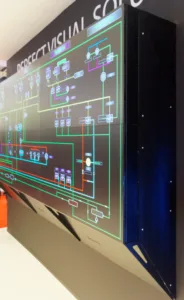Eyevis added 58″, 85″ and 98″ models to its UltraHD line which already covered 31.5″, 60″ and 84″. Brightness is 500 cd/m² on the 85″ and 98″ models which are direct lit, while the 58″ puts out 450 cd/m² and is edge-lit. Portrait or landscape operation is supported and as with other high end vendors, there are four individual DVI inputs to allow video wall simulation and control. The 85″ has an OPS module and this can be used with players to build IP-based media walls. Colour support is said to be 100% of NTSC.
 The ip-based video technology is a significant direction for Eyevis, which has what it calls an “Eyevis Processing Unit” or EPU concept combined with the company’s Ikon video wall management software. The EPUs are either stand-alone or OPS-based and allow video captured from analogue or generated in the digital domain to be flexibly routed and controlled. There was a demonstration of a traffic control application running on a 55″ UltraHD panel.
The ip-based video technology is a significant direction for Eyevis, which has what it calls an “Eyevis Processing Unit” or EPU concept combined with the company’s Ikon video wall management software. The EPUs are either stand-alone or OPS-based and allow video captured from analogue or generated in the digital domain to be flexibly routed and controlled. There was a demonstration of a traffic control application running on a 55″ UltraHD panel.
The company had a 55″ transparent OLED display on the inside of its booth and wouldn’t allow photos to be taken, but as we had a picture from Planar, that’s not a big loss! Of course, Eyevis is evaluating the product at the moment.
Finally, we had a look at the Eyevis small pitch LED technology. The company has a design of module for the LEDs that allows the corner blocks of LEDs to be easily removed as they are held in place by powerful magnets. A special frame is then mounted on the front of the LED module and allows the module to be extracted from the front, without damage. The firm told us that it is the only company that can do this without damaging the modules, but others in Hall 11 also made the same claim.
The Eyevis LEDs can be arranged in flat, concave and convex configurations, floor-standing or free-hanging and the first 2mm installation (in a TV studio) was of a concave configuration, hung from a support.

